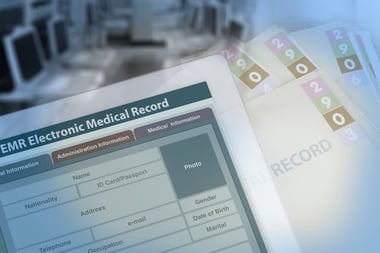 Electronic Health Record (EHR) systems have become an integral part of healthcare delivery for several decades. They enable providers to store and manage patients' information electronically, improving care quality and reducing medical errors. With the growing number of EHRs in use, there is a pressing need for these systems to be interoperable — meaning employees can communicate and exchange data seamlessly.
Electronic Health Record (EHR) systems have become an integral part of healthcare delivery for several decades. They enable providers to store and manage patients' information electronically, improving care quality and reducing medical errors. With the growing number of EHRs in use, there is a pressing need for these systems to be interoperable — meaning employees can communicate and exchange data seamlessly.
However, achieving proper integration remains difficult for hospitals. Let’s look at some of these challenges that healthcare organizations are running into when implementing EHR interoperability standards and how to overcome them.
Understanding Electronic Health Records (EHRs)
Electronic health records (EHRs) contain all the necessary details about a patient's medical history, diagnoses, medications, lab results, and other relevant information. This content is stored in an electronic format and can be examined by authorized healthcare providers from different facilities.
EHRs have several benefits over traditional paper records. They enable real-time access to patient information, reduce errors, and improve patient care. However, the lack of standardization in EHR systems has hindered seamless data sharing among different professionals.
Emerging Standards for Advanced Insights
To overcome interoperability challenges in healthcare, new standards are being developed to facilitate data exchange between different systems. Here are some of the emerging standards for advanced insights:
- Fast Healthcare Interoperability Resources (FHIR): FHIR is a new standard Health Level Seven International (HL7) created to facilitate the sharing of EHRs and other data. It uses a modern web-based approach and allows for easy integration with existing systems.
- Clinical Document Architecture (CDA): CDA is an XML-based standard used to exchange clinical documents such as discharge summaries and progress notes. It defines the structure and content of clinical documents to enable integration between different systems.
- Continuity of Care Document (CCD): CCD is a standard that enables the sharing of patient summary information between providers. It contains essential details, including allergies, medications, problem lists, and lab results.
FHIR, CDA, and CCD are just a few examples of the standards being developed to improve EHR interoperability. These standards aim to provide a common language for healthcare systems to communicate with each other and promote seamless transfer of information.
How Health Data Standards Support Healthcare Interoperability
Health data standards are crucial in achieving integration between different systems. They provide a common language, ensuring that other systems can understand and use the facts. Here are some ways in which it supports interoperability:
- Improving safety: These standards promote the accurate and complete transfer of information, reducing the risk of medical errors. It also helps to speed up the transmission of critical information, leading to better patient outcomes.
- Encouraging innovation: With standardized data, developers can create new applications and tools that can be easily integrated with different systems. This promotes innovation in the healthcare industry, leading to more efficient and effective care delivery.
- Data privacy and security: These standards also include guidelines for protecting patient information during the exchange process, ensuring the confidentiality and integrity of data.
Widespread adoption of health data standards can help overcome the difficulties of EHR interoperability and promote smooth exchange between different systems.
Challenges of Interoperability in Healthcare
Despite the benefits of health data standards, there are still challenges to achieving seamless interoperability. Some of these dilemmas include:
- Lack of standardization: The lack of standardized EHR systems makes it difficult for different systems to communicate and share details effectively.
- Human error: Inaccurate information entry or incorrect mapping of data can lead to errors in the exchange process, hindering integration. By adhering to standard formats, these human mistakes can be minimized.
- Network security threats: The transfer of sensitive patient information between systems can be vulnerable to cyber attacks, compromising patient privacy.
These problems highlight the need for robust strategies and solutions to overcome unwanted barriers.
Best Practices for Overcoming Interoperability Challenges
Although the challenges may seem daunting, healthcare organizations can adopt best practices to achieve effective integration. These include:
- Utilizing standardized health data formats: Adopting standard formats such as FHIR, CDA, and CCD can ensure consistent content sharing between different systems.
- Implementing decisive security measures: As the swapping of sensitive patient information becomes more prevalent, organizations must apply strong cyber security measures to protect data during the exchange process.
- Investing in cloud technology: Healthcare facilities should embrace cloud-based systems that offer scalability, flexibility, and cost-effectiveness among providers.
- Focusing on hiring trends in the healthcare industry: Organizations should focus on hiring trends by recruiting professionals with experience and expertise in interoperability standards to guarantee effective execution and maintenance of information exchange processes.
- Human error management: Including solid training programs and error-checking mechanisms can help reduce human errors in the sharing process.
Final Takeaways to Ensure EHR Interoperability
EHR interoperability is a critical aspect of the healthcare system that requires standardization and effective strategies for successful application. Ensuring robust security measures and reducing human errors in EHR systems are essential for maintaining patient trust and promoting efficient services. With emerging standards and advanced solutions, professionals can overcome integration issues and achieve seamless data sharing.
About the Author: Miles is an independent writer with a background in business and a passion for tech, psychology, news, and simply helping people live happy and fulfilled lives. He has lived and traveled all over the United States and continues to expand his awareness and experiences. When not writing, he is most likely mountain biking or kicking back with a cup of tea.



